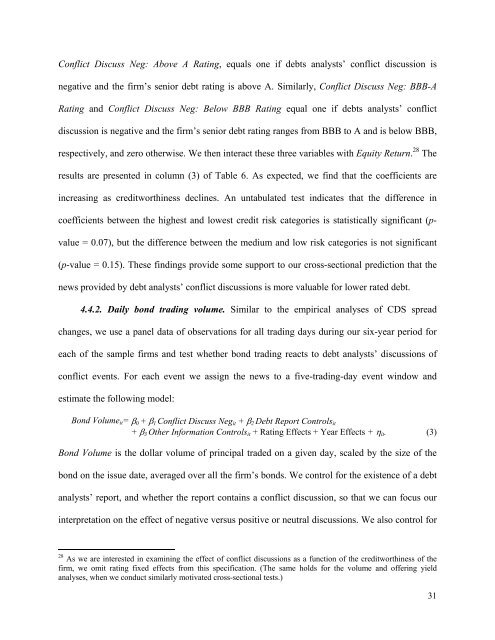Debt Analysts' Views of Debt-Equity Conflicts of Interest
Debt Analysts' Views of Debt-Equity Conflicts of Interest
Debt Analysts' Views of Debt-Equity Conflicts of Interest
You also want an ePaper? Increase the reach of your titles
YUMPU automatically turns print PDFs into web optimized ePapers that Google loves.
Conflict Discuss Neg: Above A Rating, equals one if debts analysts’ conflict discussion is<br />
negative and the firm’s senior debt rating is above A. Similarly, Conflict Discuss Neg: BBB-A<br />
Rating and Conflict Discuss Neg: Below BBB Rating equal one if debts analysts’ conflict<br />
discussion is negative and the firm’s senior debt rating ranges from BBB to A and is below BBB,<br />
respectively, and zero otherwise. We then interact these three variables with <strong>Equity</strong> Return. 28 The<br />
results are presented in column (3) <strong>of</strong> Table 6. As expected, we find that the coefficients are<br />
increasing as creditworthiness declines. An untabulated test indicates that the difference in<br />
coefficients between the highest and lowest credit risk categories is statistically significant (p-<br />
value = 0.07), but the difference between the medium and low risk categories is not significant<br />
(p-value = 0.15). These findings provide some support to our cross-sectional prediction that the<br />
news provided by debt analysts’ conflict discussions is more valuable for lower rated debt.<br />
4.4.2. Daily bond trading volume. Similar to the empirical analyses <strong>of</strong> CDS spread<br />
changes, we use a panel data <strong>of</strong> observations for all trading days during our six-year period for<br />
each <strong>of</strong> the sample firms and test whether bond trading reacts to debt analysts’ discussions <strong>of</strong><br />
conflict events. For each event we assign the news to a five-trading-day event window and<br />
estimate the following model:<br />
Bond Volumeit= 0 + 1 Conflict Discuss Negit + 2 <strong>Debt</strong> Report Controlsit<br />
+ 3 Other Information Controlsit + Rating Effects + Year Effects + it. (3)<br />
Bond Volume is the dollar volume <strong>of</strong> principal traded on a given day, scaled by the size <strong>of</strong> the<br />
bond on the issue date, averaged over all the firm’s bonds. We control for the existence <strong>of</strong> a debt<br />
analysts’ report, and whether the report contains a conflict discussion, so that we can focus our<br />
interpretation on the effect <strong>of</strong> negative versus positive or neutral discussions. We also control for<br />
28 As we are interested in examining the effect <strong>of</strong> conflict discussions as a function <strong>of</strong> the creditworthiness <strong>of</strong> the<br />
firm, we omit rating fixed effects from this specification. (The same holds for the volume and <strong>of</strong>fering yield<br />
analyses, when we conduct similarly motivated cross-sectional tests.)<br />
31
















